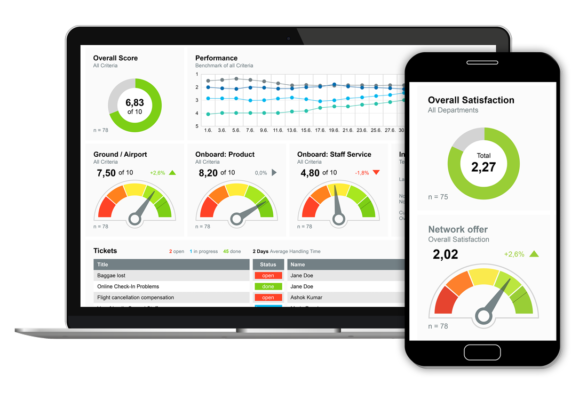5 Mistakes You Should Avoid to Strengthen Your Customers’ Loyalty
Wrong deliveries, poor product quality and long delivery times – there are many reasons for customers to complain. But being put on hold forever, only to be passed from customer service representative to customer service representative and ultimately not having found a satisfactory solution, doesn’t make it any better. In fact, good customer service is crucial to a company’s success. If customers feel neglected with their concerns, it makes them turn to the competition.
Nowadays, bad experiences spread very quickly and easily via Social Media. The impacts on the reputation of a company are detrimental. To keep happy customers, a good image and improve customer service, companies should avoid these 5 common mistakes when dealing with customers.
1. Contacting Problem
 When customers have difficulties contacting the company, it negatively impacts the entire subsequent customer interaction. Most of the time, only a small percentage of customers actually communicate their concerns. However, a small number of complaints does not necessarily mean that customers are completely satisfied with the products or services. It is more likely that they will quietly turn their backs on the organization. In this way, companies lose their customers without knowing the reasons and being able to learn from them.
When customers have difficulties contacting the company, it negatively impacts the entire subsequent customer interaction. Most of the time, only a small percentage of customers actually communicate their concerns. However, a small number of complaints does not necessarily mean that customers are completely satisfied with the products or services. It is more likely that they will quietly turn their backs on the organization. In this way, companies lose their customers without knowing the reasons and being able to learn from them.
Every person has individual communication habits. It is important to take all these habits into account to improve customer service. To achieve high response rates, multi-channel surveys offer an ideal solution to reach customers directly at different touchpoints of the customer journey through their preferred channels. Willingness to participate in surveys and submit complaints increases, when flexible, time- and location-independent channels ‒ from phone to app ‒ are made available.
2. Long Reaction Times and Lack of Transparency When Dealing With Complaints
In case a problem occurs, the customer naturally wants it to be resolved as quickly as possible. However, it is often not that easy to respond quickly and effectively to all incoming complaints. Customer concerns are often passed on to employees who have limited knowledge of the problem and cannot initially help the customer. As a result, complaints are often handed from employee to employee until a suitable solution is found. Because each employee has their own approach to handling complaints, it often takes a lot of time to resolve an issue.
It is also dangerous if the knowledge about certain concerns and facts lies with individual employees who are not present or have even left the company. This is why transparent and uniform case processing within the organization is needed to respond to customer complaints in an efficient and standardized manner.
3. Worst Case – No Reaction to Incoming Customer Complaints
 Often, complaints and inquiries end up in huge data silos and go unnoticed for a long time. If a customer’s concern is completely ignored, the person will most likely turn its back on the company. In many cases, it doesn’t stop at a silent transition to the competition. Dissatisfied customers like to share their negative experiences in the form of bad reviews on Google reviews, Trip Advisor, Amazon, etc. Since new customers often rely on these reviews, they are put off before they even make their first purchase. As a result, businesses not only lose their existing customers, but also struggle to attract new ones.
Often, complaints and inquiries end up in huge data silos and go unnoticed for a long time. If a customer’s concern is completely ignored, the person will most likely turn its back on the company. In many cases, it doesn’t stop at a silent transition to the competition. Dissatisfied customers like to share their negative experiences in the form of bad reviews on Google reviews, Trip Advisor, Amazon, etc. Since new customers often rely on these reviews, they are put off before they even make their first purchase. As a result, businesses not only lose their existing customers, but also struggle to attract new ones.
To ensure that no complaint gets lost in the multitude of customer feedback, a structured ticket system can help. Here, critical issues are prioritized according to predefined rules and forwarded to the responsible employees. In addition, all tickets and their processing status are presented in clear reports. This enables a fast and effective response to urgent issues and ensures that no inquiry is lost.
4. Inflexibility – No Goodwill and Proper Compensation
If a company shows itself to be inflexible when it comes to finding alternative solutions for the customer, it has negative impacts on customer satisfaction. By acting in a customer-oriented manner and offering quick and appropriate compensation, such as vouchers or discount codes for the next purchase, companies can show their appreciation and strengthen customer loyalty.
Acquiring new customers is between 5 and 25 times more expensive than strengthening existing customer relations. At the same time, a 5% increase in customer retention rates leads to a 25% – 95% increase in profits (source: hbr.org). With personalized offers and promotions, companies can strengthen ties with existing customers, who will share their satisfaction with those around them. The prerequisite for this is that management and employees understand the importance of good customer service and strive to provide satisfactory solutions and alternative measures.
5. Lacking Appreciation of Customer Service Within the Company
However, the greatest danger for a company is to not recognize the relevance of customer service. If customer service only happens in passing, no improvements can be initiated. Every complaint also represents an opportunity ‒ which is why companies need to make it as easy as possible to file complaints. Only then can they learn from their mistakes and better adapt their products and, above all, their services to the needs of their customers.
 Improving customer service must be approached from the customer’s point of view. What does a customer expect from the support service when a problem arises? How would he/she like to be supported by the company? First and foremost, the customer should be able to contact the company easily and conveniently via various channels. The support staff must be friendly and patient with the customer. In addition, transparency within the staff and also externally ‒ for example, via FAQs on the website ‒ plays an important role in improving customer service in the long term. A customer whose problem has been successfully resolved is usually even more satisfied than before. In order to implement all this in the long term and sustainably, a well-structured and systematic customer dialogue system is indispensable.
Improving customer service must be approached from the customer’s point of view. What does a customer expect from the support service when a problem arises? How would he/she like to be supported by the company? First and foremost, the customer should be able to contact the company easily and conveniently via various channels. The support staff must be friendly and patient with the customer. In addition, transparency within the staff and also externally ‒ for example, via FAQs on the website ‒ plays an important role in improving customer service in the long term. A customer whose problem has been successfully resolved is usually even more satisfied than before. In order to implement all this in the long term and sustainably, a well-structured and systematic customer dialogue system is indispensable.
Our Spectos Solutions to Improve Your Customer Service
 With our solutions for Customer Experience Management, concerns and feedback of all kinds can be collected via various channels (paper questionnaires can also be digitized). Complaints are automatically created as tasks in the ticket service. Responsible employees thus have quick and clear access to the processing status and processing time of customer concerns. The ticket system also gives the company the option of rapid remedial action and can define targeted measures for dealing with complaints in the future. These can be monitored in the QM reports and frequency-relevance analyses that can be accessed at any time to ensure a long-term improvement in overall Service Quality.
With our solutions for Customer Experience Management, concerns and feedback of all kinds can be collected via various channels (paper questionnaires can also be digitized). Complaints are automatically created as tasks in the ticket service. Responsible employees thus have quick and clear access to the processing status and processing time of customer concerns. The ticket system also gives the company the option of rapid remedial action and can define targeted measures for dealing with complaints in the future. These can be monitored in the QM reports and frequency-relevance analyses that can be accessed at any time to ensure a long-term improvement in overall Service Quality.
Move your customer service into the spotlight!
High prices and poor product quality themselves are usually not the reason why customers turn their backs on a company. Rather, it is inadequate service, unfriendly employees, and long waiting times or no response at all to inquiries and complaints that cause customers to leave.
To improve customer service is therefore essential to retain existing customers and win new ones. This requires transparency with regard to complaints and regular monitoring of the measures taken. Our flexible solutions for complaint management and customer dialogue enable the capture, processing, analysis and evaluation of concerns. This is done centrally and in real time within the web-based Spectos Real-Time Performance Management™ Platform, allowing a continuous identification of potential for improvement and ensuring a high level of customer satisfaction in the long term.


